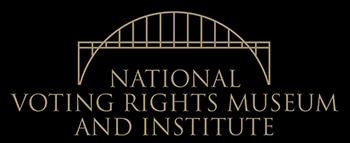Home » Alabama Museums »
6 US-80 BUS, Selma, AL 36701
National Voting Rights Museum and Institute opened in 1993 and is located in Selma, Alabama. It collects, archives, honors, chronicles, testimony and the artifacts of the activists involved in the passage of the 1965 Voting Rights Act ,Selma to Montgomery marches , Women's Suffrage movements and African-American Voting Rights. Founded by Faya Ora Rose Touré
Footprints to Freedom Tour , Combination Tour, EXHIBITS
THE MOVEMENT EXHIBIT: ST. AUGUSTINE, FL. ST. AUGUSTINE, FL., GREENWOOD, MS, ALBANY, GA. SELMA, AL ---CORE, URBAN LEAGUE, NAACP, DALLAS COUNTY VOTERS LEAGUE, SNCC,
VOTING BOOTH EXHIBIT, J.F.K. EXHIBIT, THE WINDOW EXHIBIT, KKK EXHIBIT, SHERRIF JIM CLARK, MLK EXHIBIT, JAIL EXHIBIT, NON VIOLENCE EXHIBIT, REV. JESSE LOUIS JACKSON – MOMENTS IN TIME
Monday - Thursday: 10:00 am to 4:00 pm
Friday, Saturday, Sunday:
By Appointment Only
The National Voting Rights Museum and Institute, located in Selma, Alabama, is a powerful testament to the struggle for civil rights and voting rights in the United States. The museum is dedicated to preserving the history of the Voting Rights Movement and educating the public on the importance of voting rights for all Americans.
The museum was founded in 1993 by civil rights activist and organizer Faya Rose Toure. Its mission is to commemorate and celebrate the Voting Rights Movement, which was led by prominent figures like Dr. Martin Luther King Jr. and John Lewis, and to inspire current and future generations to continue the fight for social justice and equality.
One of the museum’s most significant exhibits is the “Footprints to Freedom” walking tour, which takes visitors through historic sites in Selma that played a crucial role in the struggle for voting rights. The tour includes stops at the Edmund Pettus Bridge, the site of the Bloody Sunday march in 1965, and Brown Chapel AME Church, where many civil rights meetings and protests were held.
In addition to its exhibits, the museum also offers educational programming for visitors of all ages, including lectures, workshops, and guided tours. The museum’s “Living History” program allows visitors to interact with individuals who were involved in the Voting Rights Movement, providing a firsthand account of the struggle for equality.
The museum is an essential resource for historians, researchers, and educators, as well as anyone interested in learning more about the history of voting rights in the United States. It provides a comprehensive view of the movement and the sacrifices made by those who fought for equality, reminding visitors that voting rights are a crucial component of American democracy.
Finally, the National Voting Rights Museum and Institute serves as a call to action for individuals to become involved in the ongoing struggle for voting rights and social justice. By preserving the history of the Voting Rights Movement and inspiring future generations, the museum is helping to ensure that the fight for equality and justice continues for years to come.
In conclusion, the National Voting Rights Museum and Institute in Selma, Alabama, is a powerful tribute to the struggle for voting rights in the United States. Its exhibits, educational programming, and commitment to social justice inspire visitors to take action and continue the fight for equality and democracy. By visiting the museum, individuals can learn about the history of the Voting Rights Movement and honor those who sacrificed so much to secure voting rights for all Americans.
- Take the “Footprints to Freedom” walking tour and visit historic sites in Selma that played a crucial role in the struggle for voting rights, including the Edmund Pettus Bridge and Brown Chapel AME Church.
- Explore the museum’s exhibits and learn about the history of the Voting Rights Movement and the sacrifices made by civil rights activists.
- Attend educational programming, including lectures, workshops, and guided tours, to gain a deeper understanding of the importance of voting rights in American democracy.
- Interact with individuals who were involved in the Voting Rights Movement through the museum’s “Living History” program, providing a firsthand account of the struggle for equality.
- Research and study the museum’s extensive collection of materials related to the Voting Rights Movement, including photographs, artifacts, and documents.
- Reflect on the significance of voting rights and the ongoing struggle for social justice and equality in the United States, and consider how you can become involved in the fight for voting rights and democracy.

